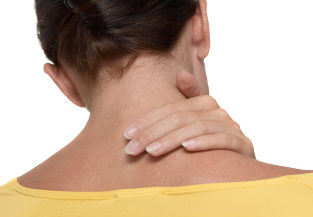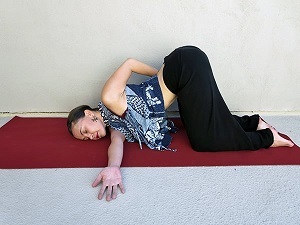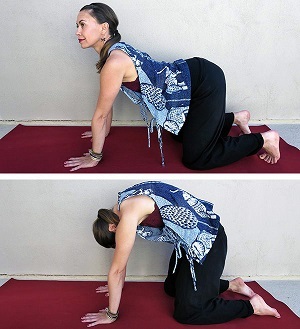Our neck consists of vertebrae that extend from the neck to the upper torso. Between the vertebrae are special discs that absorb pressure. Bones, ligaments and muscles located in the neck — all are working in order to support the head and to move it. Any anomaly, trauma or inflammation in the cervical spine leads to pain.

What to do if a sore neck? Indeed, from time to time it happens to everyone. Often this is due to stress or wrong posture. Sometimes the pain can be the consequence of injuries from a fall or playing sports.
Most often to get rid of neck pain could for a couple of days at home without additional funds, if it is very minor, goes away by itself. Sometimes it can be a warning of serious injury and illness and requires immediate specialist examination. If the pain in the cervical spine is strong, have more weeks and is accompanied by other symptoms, immediately consult a doctor.
Causes of pain in the neck
When sore neck? This may be due to a number of reasons.
Muscle tension and stretch
Most often this is due to:
- poor posture;
- too long a stay at the Desk;
- bad postures during sleep;
- injury to the neck during exercise.
Injury
Our neck is particularly vulnerable to falls, car accidents, sports and other activity, during which the muscles are forced to go beyond the usual range of motion. When fracture of the cervical vertebrae, the probability that the spinal cord may also be damaged.
Heart attack
Neck pain can be a symptom of heart attack. However, usually in such cases it appears together with other symptoms, such as:
- shortness of breath;
- sweating;
- weakness;
- vomiting;
- pain in arms or jaw.
If you notice several of these symptoms, call an Ambulance immediately.

Meningitis
Meningitis is an inflammation of the thin sheath of spinal cord and brain. In many cases, patients with meningitis, next to the fever and pain note discomfort and stagnation in the neck. This is a very dangerous disease that can lead to death. If you say the symptoms of meningitis, immediately consult a doctor.
Other reasons
- Rheumatoid arthritis causes discomfort, swelling of the joints and bone spurs. With the development of arthritis in the neck there are severe pain.
- Osteoporosis leads to weakening of bone tissue and fractures. The greatest risk usually tend hands and knees, but often suffers and neck.
- Fibromyalgia is a condition that causes muscle pain throughout the body, especially in the neck and shoulders.
- With age, there is degeneration of the intervertebral disc. This condition is known as osteoarthritis is narrowing of the space between ceruicis vertebrae, which increases the load on the neck and causes pain.
- As a result of injury intervertebral disc can begin to strongly speak out, which increases the load on the spine and nerve endings, causing discomfort.
- Spinae stenosis occurs when the spine narrows and causes pressure on the spinal cord or the nerve roots as it exits from the vertebrae. This may be a result of prolonged inflammation caused by arthritis and other diseases.
In some cases, neck pain can occur as a result of:
- congenital anomalies;
- infection;
- abscess;
- tumor;
- cancer of the spine.
When to consult a doctor
If symptoms persist for more than a week, you should consult with a specialist. You also need to go to the hospital if you have these symptoms:
- severe pain in the neck without reason;
- tumor;
- fever;
- headaches;
- swollen lymph nodes;
- weakness;
- vomiting;
- problems with swallowing and breathing;
- nausea;
- numbness;
- ringing in the ears;
- pain that spreads down to the arms or legs;
- the inability to move my arms;
- the inability to touch the chin to the chest;
- disruption of the bladder or bowel.
Also, seek immediate medical attention if pain was the result of a fall or crash.
How to treat neck pain
First the doctor will check your physical condition and medical history. Be prepared to talk about all the nuances are symptoms. It is important to mention all medications that you have taken recently. Any information about existing injuries, even if you think that it is irrelevant to the problem, which will be useful.
The method of treatment depends on the diagnosis. In addition to General inspection and analysis of your medical records, your doctor may also order additional tests:
- blood test;
- x-rays;
- computed tomography;
- MRI-scan;
- electromyography, which allows you to check the health of the muscles and their controlling nerve endings;
- lumbar or spinal puncture.
Depending on test results your doctor will refer you to the appropriate specialist. Treatment may include:
- calor justo;
- Physical therapy and stretching;
- painkillers;
- corticosteroid injections;
- muscle relaxants;
- neck brace;
- tractu traction of the spine;
- antibiotics (if infection);
- hospital treatment (with meningitis and heart attack);
- surgery (rarely used).
Alternative treatment is:
- acupuncture;
- chiropractic;
- massage;
- transcutaneous electrical nerve stimulation.
Whatever treatment, make sure that appealed to a certified specialist.

How to get rid of neck pain at home
If the pain is minor, try the following treatment methods:
- The first couple of days apply a cold compress to the damaged region. Immediately after this, use hot compress or take a hot shower;
- Take over-the-counter pain relievers, such as ibuprofen and acetaminophen;
- For a few days, refrain from sports, lifting weights and activity that increases pain. Decreasing symptoms gradually return to normal activity level;
- Every day do exercises for the neck. Slowly pull the head from side to side, top to bottom;
- Follow the carriage;
- During a conversation not to pinch the phone between the neck and the shoulder;
- Change your body position. Don't sit and don't wait too long without movement;
- Make a light massage of the neck;
- While sleeping, use a special pillow for the neck;
- Do not wear a neck brace without consulting with a specialist. Improper use may worsen the symptoms.
Stretching helps to forget about the pain
During operation, try to keep the monitor was at eye level, sit up straight, keep your back straight, do not recurvus and don't hang your head too low. While you are driving or surfing the Internet try to give myself a little rest periods to cervical vertebrae did not go too far ahead.
The key to recovery from pain — the right moves and proper stretching. The following exercises for back and neck you can do at work, behind the wheel:
- Make 10 circular movements of the shoulders back;
- 10 times keep blades together;
- Holding the head straight, as much push back in the chair and hold this position for 30 seconds;
- Tilt your head to the side as close to the shoulder, 10 times on each side.
Be careful in your sleep
If you are often concerned about pain in the cervical spine, you should be careful about in what circumstances and in what position you sleep. Try to sleep on your side or back — never sleep on your stomach.
When you sleep on your stomach, turn your head to either side and neck freezes for a few hours in an uncomfortable position. This dream may have a negative impact on the lower back, as in the absence of proper support to the abdomen "falls down.
When the minor pain, in addition to exercise, consider the following guidelines:
- Apply to the affected area cold or hot compress. The first 48-72 hours, use ice, then go for hot compresses. Do not use the compress during sleep, as this may cause injury.
- Take over-the-counter pain relievers, such as ibuprofen and acetaminophen;
- Keep moving, but eliminate those movements which increase the pain. This will help reduce symptoms and inflammation.
- Make a light massage of the neck.
- Try sleeping on a firm mattress without a pillow or on a special pillow for the neck.
- Ask your doctor about the need to use a neck brace. Don't wear the brace too long, it can weaken the muscles.
9 yoga exercises for neck
Yoga is another good way to get rid of pain.
1. Hands across the chest
Conveniently sit on the floor or on a chair with a straight back, shoulders relaxed, long neck. Pull your right hand so that she was shoulder height, and bring it to the left. Turn your head, look over your right shoulder. This pose allows you to stretch the muscles of the neck and back of shoulders. Hold this position for 8-10 breaths, then repeat with the left hand.

2. Out "thread the needle in a needle"
Get on all fours, knees at an angle relative to the thighs. Extend your left arm forward and slide right under it. Get down on the floor right shoulder and cheek. Close your eyes, relax, think about stretching the muscles of the shoulders, arms, upper back and neck. Hold this position for 8-10 breaths, then repeat with the left hand.
3. Hands eagle
Stand or sit in a comfortable position, spine straight, neck is elongated. Extend both arms so that they were shoulder width and shoulder height. Bend your right hand to the head and slide your left hand under the right. Bend and rotate your left arm around his right. The ultimate goal is to touch the palms. It may take some time, so if you have not, then place your left hand over the right wrist. Breathe deeply. Lower the shoulders, gently pull the hands from your face and slowly rotate the head toward the left shoulder. This pose allows you to stretch the muscles of the arms, shoulders, upper back and neck. Hold this position for at least 5 breaths (ideally 10). Repeat with the other side.
4. Circular movements of the head
Conveniently sit on the floor or on a chair with a straight back, shoulders relaxed, neck extended. Lower your chin to your chest, then slowly lower your head to the right, trying to touch right ear to right shoulder. Dip the fingertips of his left hand on his left shoulder and right hand over the left ear. The harder you push your hands to the shoulder and the ear, the more stretch muscles. This exercise from the pain in my neck and shoulders. Repeat with the other side.
5. Circular motion of the shoulders
Stand or sit in a comfortable position, keep the back straight. Place the fingertips on the shoulders. Bring your elbows towards each other in front of the body to stretch the shoulders and upper back. Up — to stretch the triceps. In the side — to stretch the chest and front shoulders. Stretch the elbows to each other on the back to stretch the deep muscles of the shoulders and chest.
6. Stretching Cat
Get on all fours, knees at an angle relative to the thighs. On every breath deflect back, gaze directed at the ceiling. Each time you exhale pull your chin to your chest, pull your tailbone under him, round the back. This exercise helps to stretch the muscles of the neck, chest, shoulders, back and waist. Hold each position for 8-10 breaths-exhalations.

7. Arm to the elbow
Stand or sit in a comfortable position, keep the back straight. Raise your right hand up, elbow bent and push between the shoulder blades. The left palm, place the right elbow and gently press to enhance the stretching of the muscles. This pose allows you to stretch the muscles of the shoulders, triceps, back, and neck. Hold the position for 8-10 breaths. Repeat with the other side.
8. Hands in the castle behind
Stand straight with feet shoulder width apart. Put your arms back and touch your palms. Raise your hands as high as possible, until then, until you feel the stretch the front part of the shoulders. Hold the position for 8-10 breaths.
9. Fish pose with support
Sit on the floor, legs pull in front of you, bend at the knees. Place a small pile of two blankets or yoga block behind you so that when you lean back, one was between the shoulder blades and the other under my head. Become back on the blocks, keep your hands relaxed at the sides of the torso. This pose allows you to stretch the muscles of the neck and chest and front part of the shoulders. Hold the position for 8-10 breaths.





































